An Investigation into HRM Training and Development in the Middle East
VerifiedAdded on 2023/01/12
|62
|18916
|42
Report
AI Summary
This report investigates the training and development challenges within Human Resource Management (HRM) in the Middle East, focusing on their impact on professional growth. It explores issues like cultural differences, language barriers, and the dispersed workforce, which complicate HRM practices. The study examines the role of training and development in fostering professional advancement and identifies specific issues faced by HR managers in the region. The research employs a quantitative methodology, utilizing questionnaires and secondary sources to gather data and support its findings. The report also analyzes government initiatives aimed at addressing these challenges and offers recommendations for improving training and development processes. The conclusion highlights the dominance of local cultures and languages, and suggests measures to mitigate these challenges, thus enhancing HR professional development. The report includes an abstract, introduction, literature review, methodology, findings, conclusion, recommendations, limitations, and a reflective statement.

HRM in Middle East
Paraphrase This Document
Need a fresh take? Get an instant paraphrase of this document with our AI Paraphraser
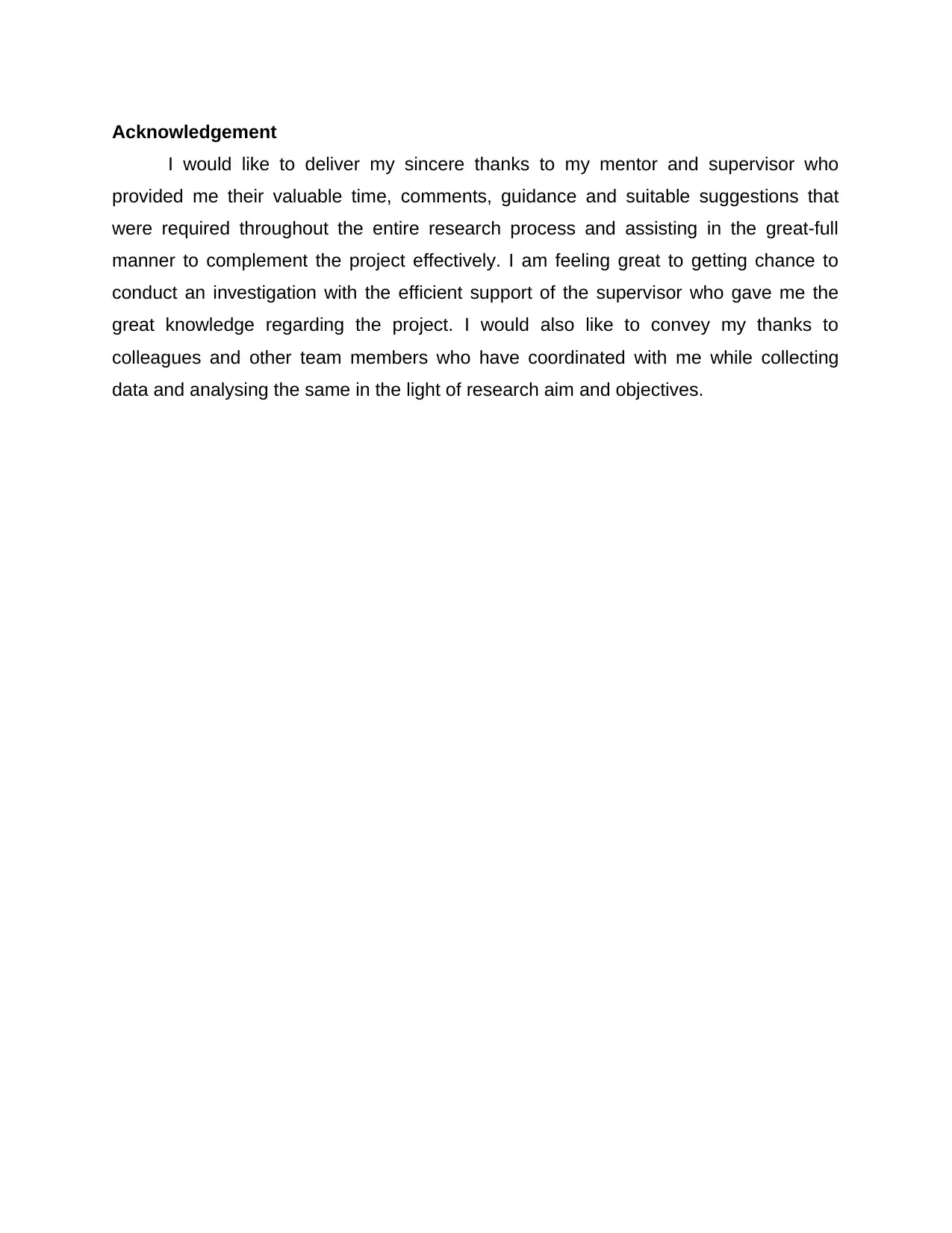
Acknowledgement
I would like to deliver my sincere thanks to my mentor and supervisor who
provided me their valuable time, comments, guidance and suitable suggestions that
were required throughout the entire research process and assisting in the great-full
manner to complement the project effectively. I am feeling great to getting chance to
conduct an investigation with the efficient support of the supervisor who gave me the
great knowledge regarding the project. I would also like to convey my thanks to
colleagues and other team members who have coordinated with me while collecting
data and analysing the same in the light of research aim and objectives.
I would like to deliver my sincere thanks to my mentor and supervisor who
provided me their valuable time, comments, guidance and suitable suggestions that
were required throughout the entire research process and assisting in the great-full
manner to complement the project effectively. I am feeling great to getting chance to
conduct an investigation with the efficient support of the supervisor who gave me the
great knowledge regarding the project. I would also like to convey my thanks to
colleagues and other team members who have coordinated with me while collecting
data and analysing the same in the light of research aim and objectives.
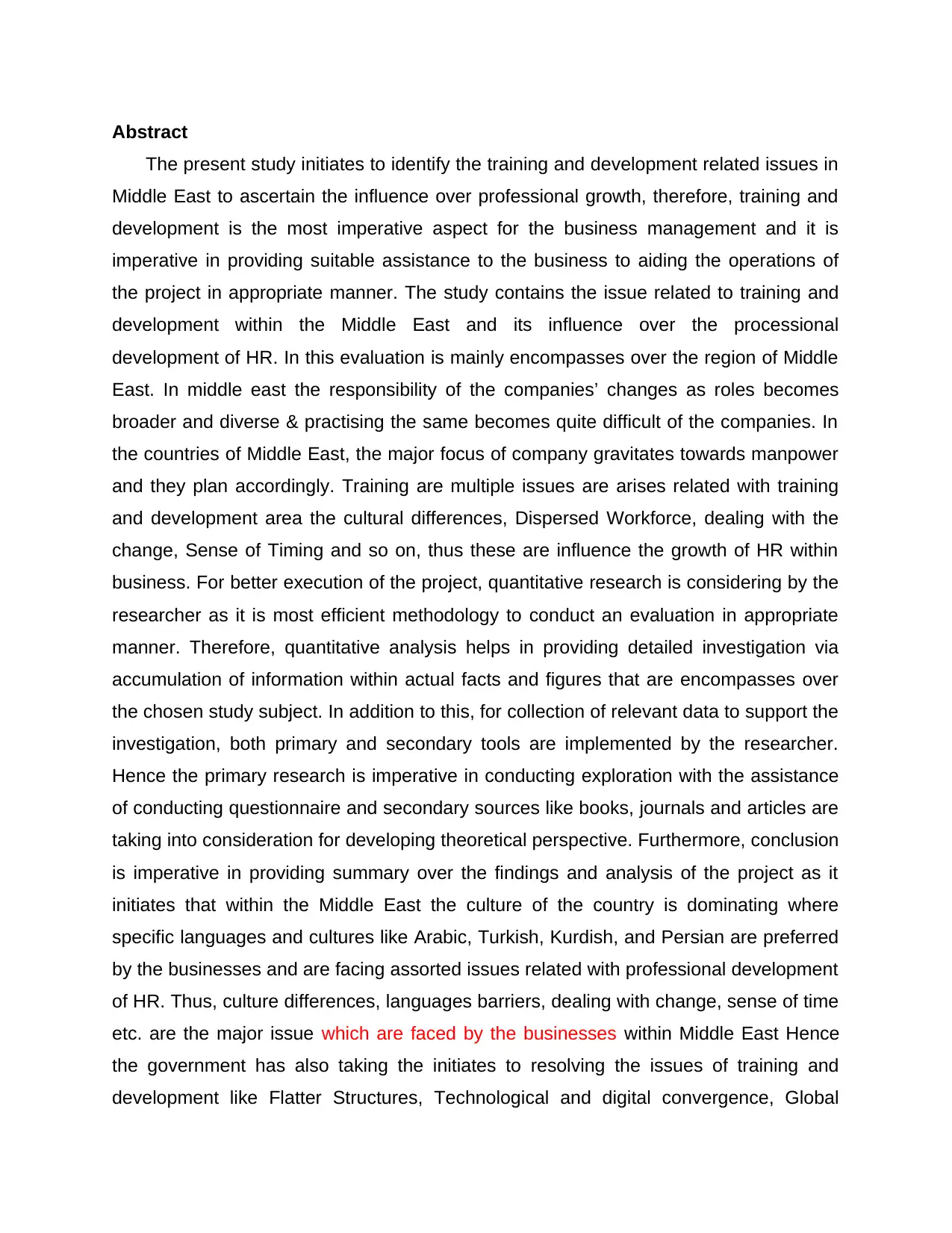
Abstract
The present study initiates to identify the training and development related issues in
Middle East to ascertain the influence over professional growth, therefore, training and
development is the most imperative aspect for the business management and it is
imperative in providing suitable assistance to the business to aiding the operations of
the project in appropriate manner. The study contains the issue related to training and
development within the Middle East and its influence over the processional
development of HR. In this evaluation is mainly encompasses over the region of Middle
East. In middle east the responsibility of the companies’ changes as roles becomes
broader and diverse & practising the same becomes quite difficult of the companies. In
the countries of Middle East, the major focus of company gravitates towards manpower
and they plan accordingly. Training are multiple issues are arises related with training
and development area the cultural differences, Dispersed Workforce, dealing with the
change, Sense of Timing and so on, thus these are influence the growth of HR within
business. For better execution of the project, quantitative research is considering by the
researcher as it is most efficient methodology to conduct an evaluation in appropriate
manner. Therefore, quantitative analysis helps in providing detailed investigation via
accumulation of information within actual facts and figures that are encompasses over
the chosen study subject. In addition to this, for collection of relevant data to support the
investigation, both primary and secondary tools are implemented by the researcher.
Hence the primary research is imperative in conducting exploration with the assistance
of conducting questionnaire and secondary sources like books, journals and articles are
taking into consideration for developing theoretical perspective. Furthermore, conclusion
is imperative in providing summary over the findings and analysis of the project as it
initiates that within the Middle East the culture of the country is dominating where
specific languages and cultures like Arabic, Turkish, Kurdish, and Persian are preferred
by the businesses and are facing assorted issues related with professional development
of HR. Thus, culture differences, languages barriers, dealing with change, sense of time
etc. are the major issue which are faced by the businesses within Middle East Hence
the government has also taking the initiates to resolving the issues of training and
development like Flatter Structures, Technological and digital convergence, Global
The present study initiates to identify the training and development related issues in
Middle East to ascertain the influence over professional growth, therefore, training and
development is the most imperative aspect for the business management and it is
imperative in providing suitable assistance to the business to aiding the operations of
the project in appropriate manner. The study contains the issue related to training and
development within the Middle East and its influence over the processional
development of HR. In this evaluation is mainly encompasses over the region of Middle
East. In middle east the responsibility of the companies’ changes as roles becomes
broader and diverse & practising the same becomes quite difficult of the companies. In
the countries of Middle East, the major focus of company gravitates towards manpower
and they plan accordingly. Training are multiple issues are arises related with training
and development area the cultural differences, Dispersed Workforce, dealing with the
change, Sense of Timing and so on, thus these are influence the growth of HR within
business. For better execution of the project, quantitative research is considering by the
researcher as it is most efficient methodology to conduct an evaluation in appropriate
manner. Therefore, quantitative analysis helps in providing detailed investigation via
accumulation of information within actual facts and figures that are encompasses over
the chosen study subject. In addition to this, for collection of relevant data to support the
investigation, both primary and secondary tools are implemented by the researcher.
Hence the primary research is imperative in conducting exploration with the assistance
of conducting questionnaire and secondary sources like books, journals and articles are
taking into consideration for developing theoretical perspective. Furthermore, conclusion
is imperative in providing summary over the findings and analysis of the project as it
initiates that within the Middle East the culture of the country is dominating where
specific languages and cultures like Arabic, Turkish, Kurdish, and Persian are preferred
by the businesses and are facing assorted issues related with professional development
of HR. Thus, culture differences, languages barriers, dealing with change, sense of time
etc. are the major issue which are faced by the businesses within Middle East Hence
the government has also taking the initiates to resolving the issues of training and
development like Flatter Structures, Technological and digital convergence, Global
⊘ This is a preview!⊘
Do you want full access?
Subscribe today to unlock all pages.

Trusted by 1+ million students worldwide
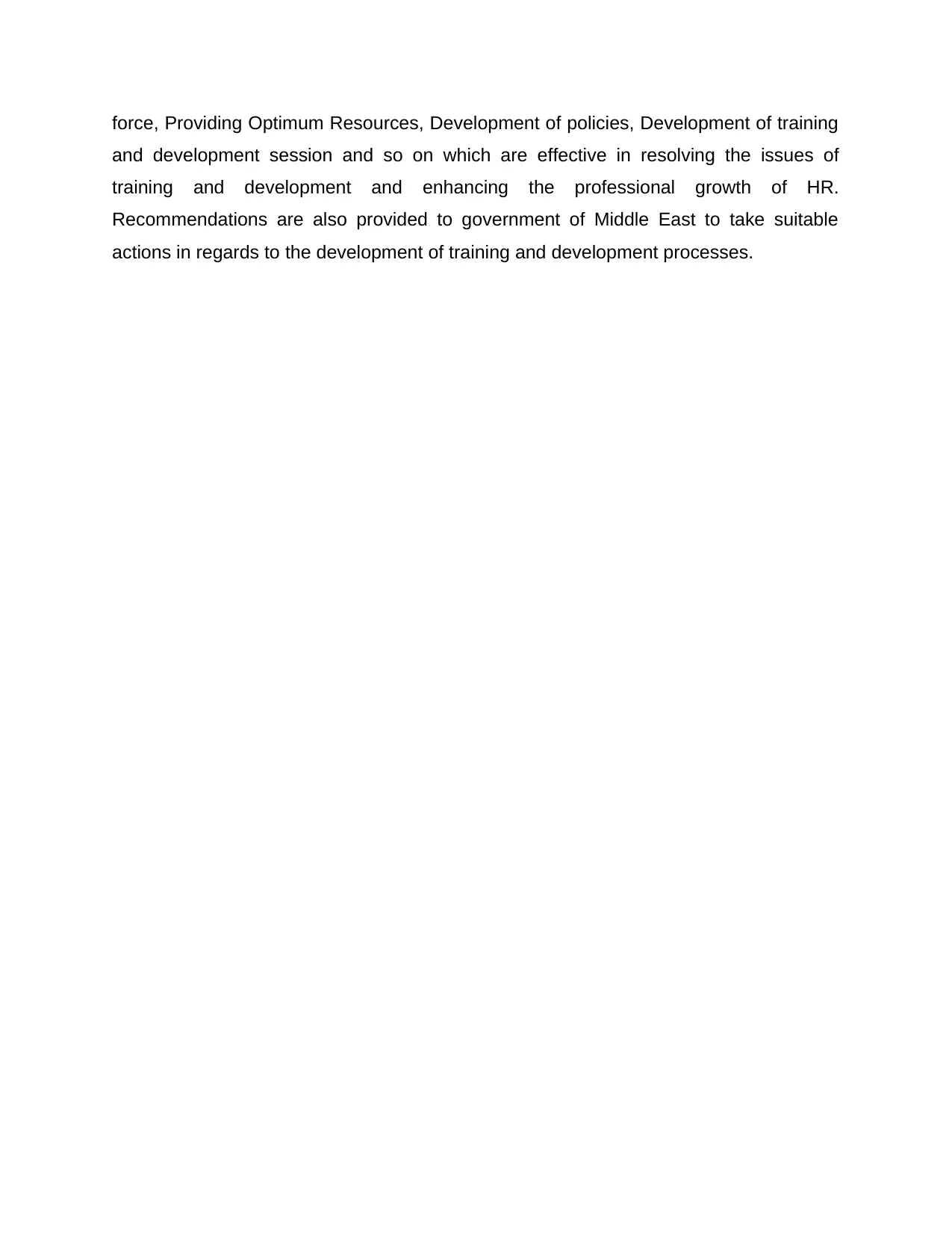
force, Providing Optimum Resources, Development of policies, Development of training
and development session and so on which are effective in resolving the issues of
training and development and enhancing the professional growth of HR.
Recommendations are also provided to government of Middle East to take suitable
actions in regards to the development of training and development processes.
and development session and so on which are effective in resolving the issues of
training and development and enhancing the professional growth of HR.
Recommendations are also provided to government of Middle East to take suitable
actions in regards to the development of training and development processes.
Paraphrase This Document
Need a fresh take? Get an instant paraphrase of this document with our AI Paraphraser
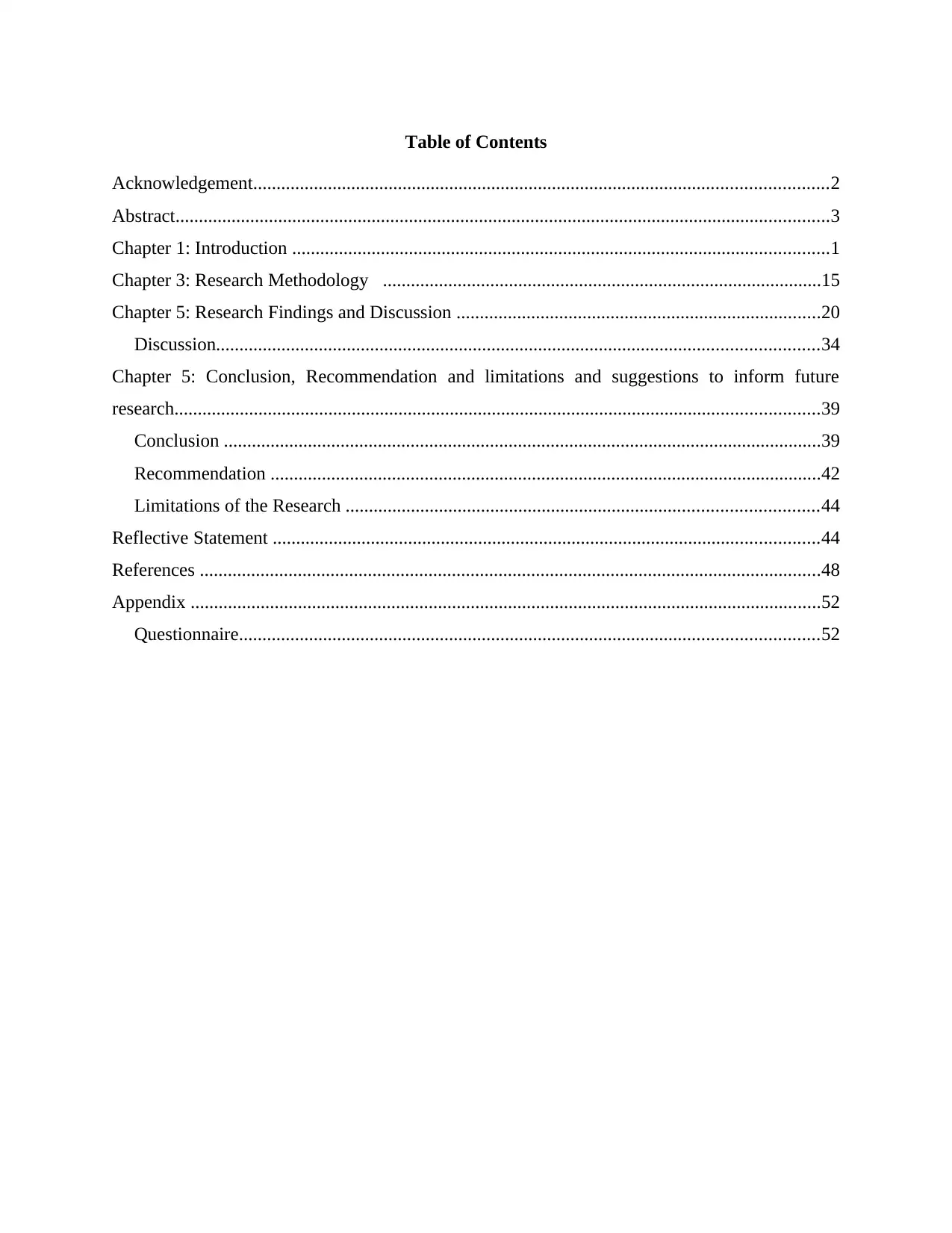
Table of Contents
Acknowledgement...........................................................................................................................2
Abstract............................................................................................................................................3
Chapter 1: Introduction ...................................................................................................................1
Chapter 3: Research Methodology ..............................................................................................15
Chapter 5: Research Findings and Discussion ..............................................................................20
Discussion.................................................................................................................................34
Chapter 5: Conclusion, Recommendation and limitations and suggestions to inform future
research..........................................................................................................................................39
Conclusion ................................................................................................................................39
Recommendation ......................................................................................................................42
Limitations of the Research .....................................................................................................44
Reflective Statement .....................................................................................................................44
References .....................................................................................................................................48
Appendix .......................................................................................................................................52
Questionnaire............................................................................................................................52
Acknowledgement...........................................................................................................................2
Abstract............................................................................................................................................3
Chapter 1: Introduction ...................................................................................................................1
Chapter 3: Research Methodology ..............................................................................................15
Chapter 5: Research Findings and Discussion ..............................................................................20
Discussion.................................................................................................................................34
Chapter 5: Conclusion, Recommendation and limitations and suggestions to inform future
research..........................................................................................................................................39
Conclusion ................................................................................................................................39
Recommendation ......................................................................................................................42
Limitations of the Research .....................................................................................................44
Reflective Statement .....................................................................................................................44
References .....................................................................................................................................48
Appendix .......................................................................................................................................52
Questionnaire............................................................................................................................52
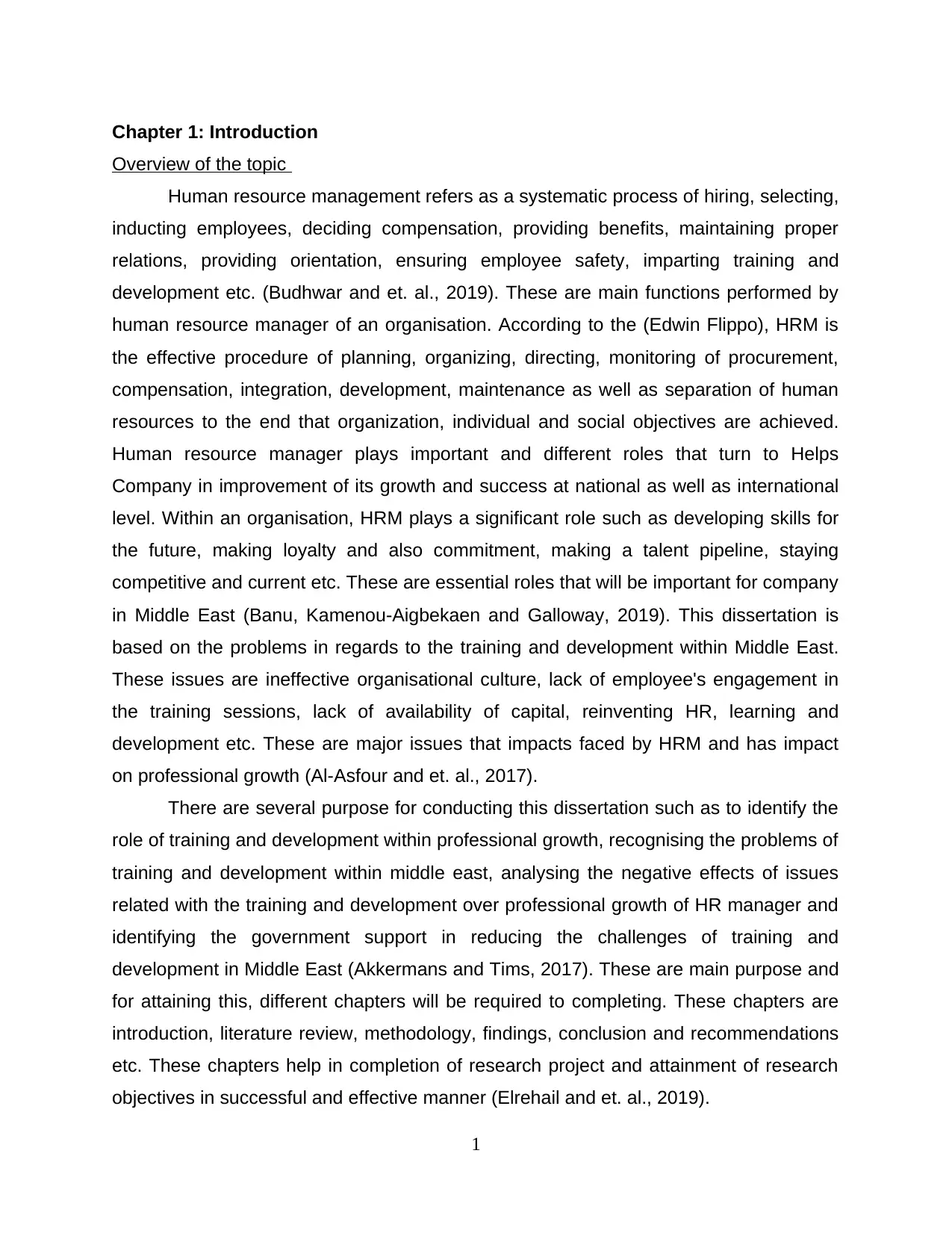
Chapter 1: Introduction
Overview of the topic
Human resource management refers as a systematic process of hiring, selecting,
inducting employees, deciding compensation, providing benefits, maintaining proper
relations, providing orientation, ensuring employee safety, imparting training and
development etc. (Budhwar and et. al., 2019). These are main functions performed by
human resource manager of an organisation. According to the (Edwin Flippo), HRM is
the effective procedure of planning, organizing, directing, monitoring of procurement,
compensation, integration, development, maintenance as well as separation of human
resources to the end that organization, individual and social objectives are achieved.
Human resource manager plays important and different roles that turn to Helps
Company in improvement of its growth and success at national as well as international
level. Within an organisation, HRM plays a significant role such as developing skills for
the future, making loyalty and also commitment, making a talent pipeline, staying
competitive and current etc. These are essential roles that will be important for company
in Middle East (Banu, Kamenou-Aigbekaen and Galloway, 2019). This dissertation is
based on the problems in regards to the training and development within Middle East.
These issues are ineffective organisational culture, lack of employee's engagement in
the training sessions, lack of availability of capital, reinventing HR, learning and
development etc. These are major issues that impacts faced by HRM and has impact
on professional growth (Al-Asfour and et. al., 2017).
There are several purpose for conducting this dissertation such as to identify the
role of training and development within professional growth, recognising the problems of
training and development within middle east, analysing the negative effects of issues
related with the training and development over professional growth of HR manager and
identifying the government support in reducing the challenges of training and
development in Middle East (Akkermans and Tims, 2017). These are main purpose and
for attaining this, different chapters will be required to completing. These chapters are
introduction, literature review, methodology, findings, conclusion and recommendations
etc. These chapters help in completion of research project and attainment of research
objectives in successful and effective manner (Elrehail and et. al., 2019).
1
Overview of the topic
Human resource management refers as a systematic process of hiring, selecting,
inducting employees, deciding compensation, providing benefits, maintaining proper
relations, providing orientation, ensuring employee safety, imparting training and
development etc. (Budhwar and et. al., 2019). These are main functions performed by
human resource manager of an organisation. According to the (Edwin Flippo), HRM is
the effective procedure of planning, organizing, directing, monitoring of procurement,
compensation, integration, development, maintenance as well as separation of human
resources to the end that organization, individual and social objectives are achieved.
Human resource manager plays important and different roles that turn to Helps
Company in improvement of its growth and success at national as well as international
level. Within an organisation, HRM plays a significant role such as developing skills for
the future, making loyalty and also commitment, making a talent pipeline, staying
competitive and current etc. These are essential roles that will be important for company
in Middle East (Banu, Kamenou-Aigbekaen and Galloway, 2019). This dissertation is
based on the problems in regards to the training and development within Middle East.
These issues are ineffective organisational culture, lack of employee's engagement in
the training sessions, lack of availability of capital, reinventing HR, learning and
development etc. These are major issues that impacts faced by HRM and has impact
on professional growth (Al-Asfour and et. al., 2017).
There are several purpose for conducting this dissertation such as to identify the
role of training and development within professional growth, recognising the problems of
training and development within middle east, analysing the negative effects of issues
related with the training and development over professional growth of HR manager and
identifying the government support in reducing the challenges of training and
development in Middle East (Akkermans and Tims, 2017). These are main purpose and
for attaining this, different chapters will be required to completing. These chapters are
introduction, literature review, methodology, findings, conclusion and recommendations
etc. These chapters help in completion of research project and attainment of research
objectives in successful and effective manner (Elrehail and et. al., 2019).
1
⊘ This is a preview!⊘
Do you want full access?
Subscribe today to unlock all pages.

Trusted by 1+ million students worldwide
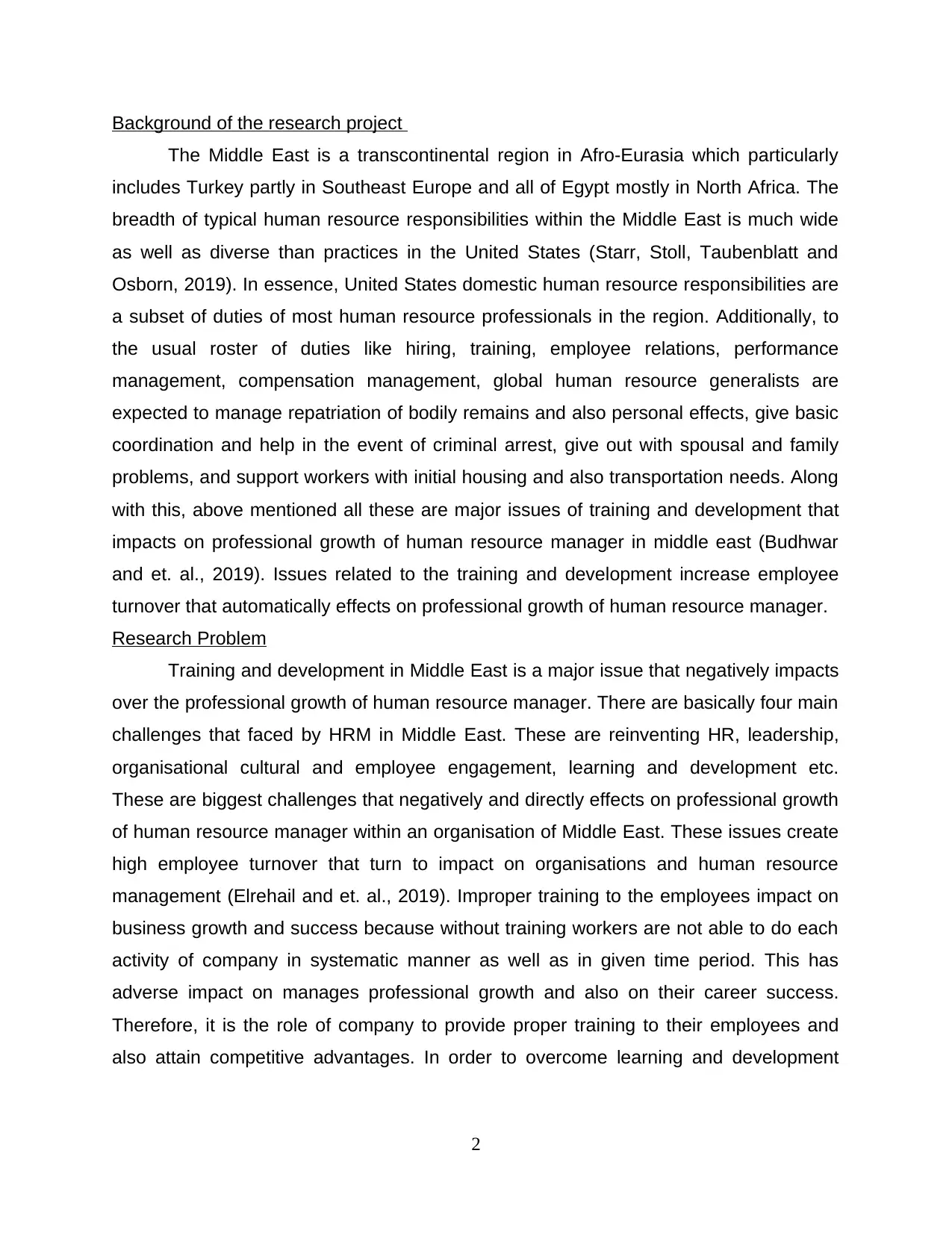
Background of the research project
The Middle East is a transcontinental region in Afro-Eurasia which particularly
includes Turkey partly in Southeast Europe and all of Egypt mostly in North Africa. The
breadth of typical human resource responsibilities within the Middle East is much wide
as well as diverse than practices in the United States (Starr, Stoll, Taubenblatt and
Osborn, 2019). In essence, United States domestic human resource responsibilities are
a subset of duties of most human resource professionals in the region. Additionally, to
the usual roster of duties like hiring, training, employee relations, performance
management, compensation management, global human resource generalists are
expected to manage repatriation of bodily remains and also personal effects, give basic
coordination and help in the event of criminal arrest, give out with spousal and family
problems, and support workers with initial housing and also transportation needs. Along
with this, above mentioned all these are major issues of training and development that
impacts on professional growth of human resource manager in middle east (Budhwar
and et. al., 2019). Issues related to the training and development increase employee
turnover that automatically effects on professional growth of human resource manager.
Research Problem
Training and development in Middle East is a major issue that negatively impacts
over the professional growth of human resource manager. There are basically four main
challenges that faced by HRM in Middle East. These are reinventing HR, leadership,
organisational cultural and employee engagement, learning and development etc.
These are biggest challenges that negatively and directly effects on professional growth
of human resource manager within an organisation of Middle East. These issues create
high employee turnover that turn to impact on organisations and human resource
management (Elrehail and et. al., 2019). Improper training to the employees impact on
business growth and success because without training workers are not able to do each
activity of company in systematic manner as well as in given time period. This has
adverse impact on manages professional growth and also on their career success.
Therefore, it is the role of company to provide proper training to their employees and
also attain competitive advantages. In order to overcome learning and development
2
The Middle East is a transcontinental region in Afro-Eurasia which particularly
includes Turkey partly in Southeast Europe and all of Egypt mostly in North Africa. The
breadth of typical human resource responsibilities within the Middle East is much wide
as well as diverse than practices in the United States (Starr, Stoll, Taubenblatt and
Osborn, 2019). In essence, United States domestic human resource responsibilities are
a subset of duties of most human resource professionals in the region. Additionally, to
the usual roster of duties like hiring, training, employee relations, performance
management, compensation management, global human resource generalists are
expected to manage repatriation of bodily remains and also personal effects, give basic
coordination and help in the event of criminal arrest, give out with spousal and family
problems, and support workers with initial housing and also transportation needs. Along
with this, above mentioned all these are major issues of training and development that
impacts on professional growth of human resource manager in middle east (Budhwar
and et. al., 2019). Issues related to the training and development increase employee
turnover that automatically effects on professional growth of human resource manager.
Research Problem
Training and development in Middle East is a major issue that negatively impacts
over the professional growth of human resource manager. There are basically four main
challenges that faced by HRM in Middle East. These are reinventing HR, leadership,
organisational cultural and employee engagement, learning and development etc.
These are biggest challenges that negatively and directly effects on professional growth
of human resource manager within an organisation of Middle East. These issues create
high employee turnover that turn to impact on organisations and human resource
management (Elrehail and et. al., 2019). Improper training to the employees impact on
business growth and success because without training workers are not able to do each
activity of company in systematic manner as well as in given time period. This has
adverse impact on manages professional growth and also on their career success.
Therefore, it is the role of company to provide proper training to their employees and
also attain competitive advantages. In order to overcome learning and development
2
Paraphrase This Document
Need a fresh take? Get an instant paraphrase of this document with our AI Paraphraser
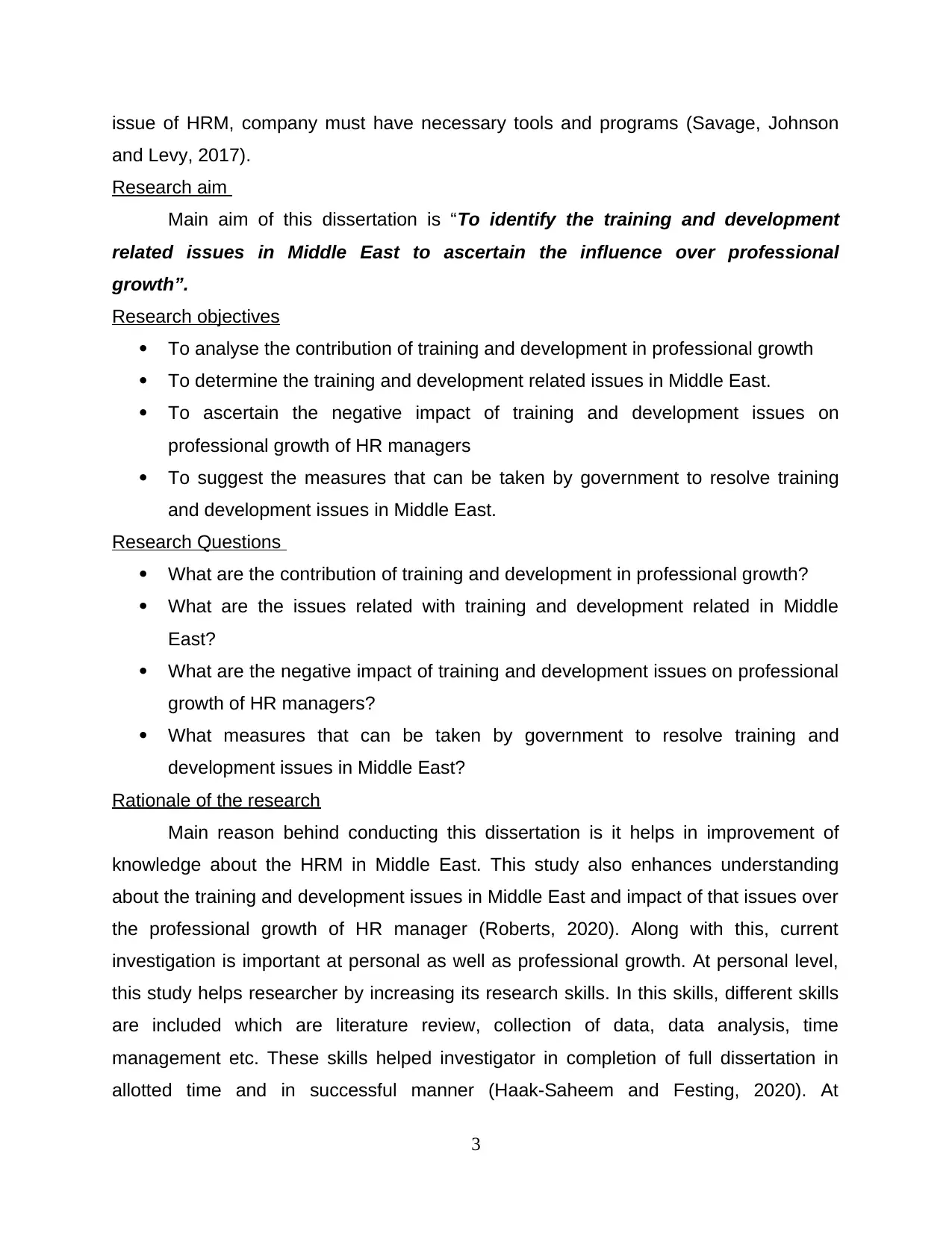
issue of HRM, company must have necessary tools and programs (Savage, Johnson
and Levy, 2017).
Research aim
Main aim of this dissertation is “To identify the training and development
related issues in Middle East to ascertain the influence over professional
growth”.
Research objectives
To analyse the contribution of training and development in professional growth
To determine the training and development related issues in Middle East.
To ascertain the negative impact of training and development issues on
professional growth of HR managers
To suggest the measures that can be taken by government to resolve training
and development issues in Middle East.
Research Questions
What are the contribution of training and development in professional growth?
What are the issues related with training and development related in Middle
East?
What are the negative impact of training and development issues on professional
growth of HR managers?
What measures that can be taken by government to resolve training and
development issues in Middle East?
Rationale of the research
Main reason behind conducting this dissertation is it helps in improvement of
knowledge about the HRM in Middle East. This study also enhances understanding
about the training and development issues in Middle East and impact of that issues over
the professional growth of HR manager (Roberts, 2020). Along with this, current
investigation is important at personal as well as professional growth. At personal level,
this study helps researcher by increasing its research skills. In this skills, different skills
are included which are literature review, collection of data, data analysis, time
management etc. These skills helped investigator in completion of full dissertation in
allotted time and in successful manner (Haak-Saheem and Festing, 2020). At
3
and Levy, 2017).
Research aim
Main aim of this dissertation is “To identify the training and development
related issues in Middle East to ascertain the influence over professional
growth”.
Research objectives
To analyse the contribution of training and development in professional growth
To determine the training and development related issues in Middle East.
To ascertain the negative impact of training and development issues on
professional growth of HR managers
To suggest the measures that can be taken by government to resolve training
and development issues in Middle East.
Research Questions
What are the contribution of training and development in professional growth?
What are the issues related with training and development related in Middle
East?
What are the negative impact of training and development issues on professional
growth of HR managers?
What measures that can be taken by government to resolve training and
development issues in Middle East?
Rationale of the research
Main reason behind conducting this dissertation is it helps in improvement of
knowledge about the HRM in Middle East. This study also enhances understanding
about the training and development issues in Middle East and impact of that issues over
the professional growth of HR manager (Roberts, 2020). Along with this, current
investigation is important at personal as well as professional growth. At personal level,
this study helps researcher by increasing its research skills. In this skills, different skills
are included which are literature review, collection of data, data analysis, time
management etc. These skills helped investigator in completion of full dissertation in
allotted time and in successful manner (Haak-Saheem and Festing, 2020). At
3
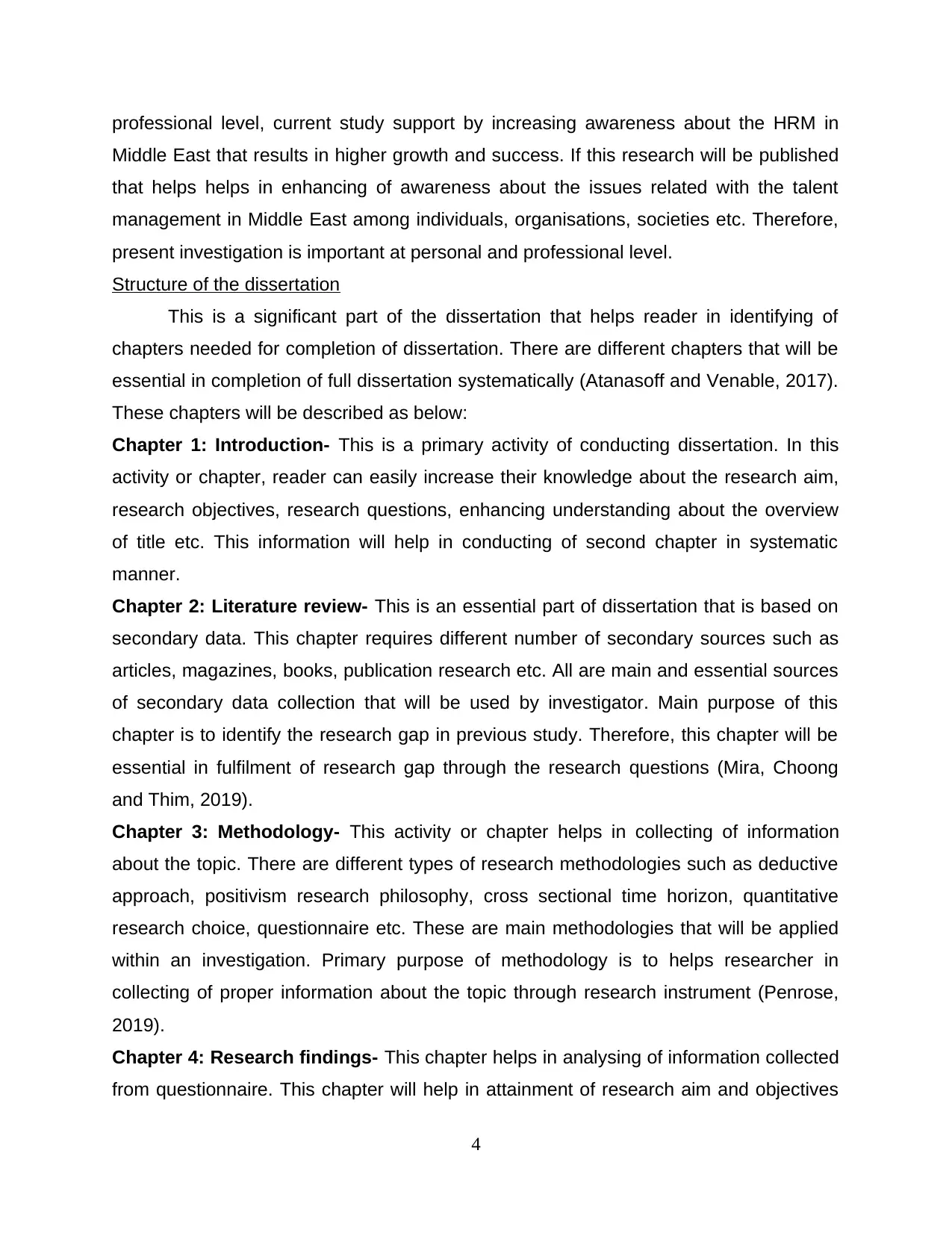
professional level, current study support by increasing awareness about the HRM in
Middle East that results in higher growth and success. If this research will be published
that helps helps in enhancing of awareness about the issues related with the talent
management in Middle East among individuals, organisations, societies etc. Therefore,
present investigation is important at personal and professional level.
Structure of the dissertation
This is a significant part of the dissertation that helps reader in identifying of
chapters needed for completion of dissertation. There are different chapters that will be
essential in completion of full dissertation systematically (Atanasoff and Venable, 2017).
These chapters will be described as below:
Chapter 1: Introduction- This is a primary activity of conducting dissertation. In this
activity or chapter, reader can easily increase their knowledge about the research aim,
research objectives, research questions, enhancing understanding about the overview
of title etc. This information will help in conducting of second chapter in systematic
manner.
Chapter 2: Literature review- This is an essential part of dissertation that is based on
secondary data. This chapter requires different number of secondary sources such as
articles, magazines, books, publication research etc. All are main and essential sources
of secondary data collection that will be used by investigator. Main purpose of this
chapter is to identify the research gap in previous study. Therefore, this chapter will be
essential in fulfilment of research gap through the research questions (Mira, Choong
and Thim, 2019).
Chapter 3: Methodology- This activity or chapter helps in collecting of information
about the topic. There are different types of research methodologies such as deductive
approach, positivism research philosophy, cross sectional time horizon, quantitative
research choice, questionnaire etc. These are main methodologies that will be applied
within an investigation. Primary purpose of methodology is to helps researcher in
collecting of proper information about the topic through research instrument (Penrose,
2019).
Chapter 4: Research findings- This chapter helps in analysing of information collected
from questionnaire. This chapter will help in attainment of research aim and objectives
4
Middle East that results in higher growth and success. If this research will be published
that helps helps in enhancing of awareness about the issues related with the talent
management in Middle East among individuals, organisations, societies etc. Therefore,
present investigation is important at personal and professional level.
Structure of the dissertation
This is a significant part of the dissertation that helps reader in identifying of
chapters needed for completion of dissertation. There are different chapters that will be
essential in completion of full dissertation systematically (Atanasoff and Venable, 2017).
These chapters will be described as below:
Chapter 1: Introduction- This is a primary activity of conducting dissertation. In this
activity or chapter, reader can easily increase their knowledge about the research aim,
research objectives, research questions, enhancing understanding about the overview
of title etc. This information will help in conducting of second chapter in systematic
manner.
Chapter 2: Literature review- This is an essential part of dissertation that is based on
secondary data. This chapter requires different number of secondary sources such as
articles, magazines, books, publication research etc. All are main and essential sources
of secondary data collection that will be used by investigator. Main purpose of this
chapter is to identify the research gap in previous study. Therefore, this chapter will be
essential in fulfilment of research gap through the research questions (Mira, Choong
and Thim, 2019).
Chapter 3: Methodology- This activity or chapter helps in collecting of information
about the topic. There are different types of research methodologies such as deductive
approach, positivism research philosophy, cross sectional time horizon, quantitative
research choice, questionnaire etc. These are main methodologies that will be applied
within an investigation. Primary purpose of methodology is to helps researcher in
collecting of proper information about the topic through research instrument (Penrose,
2019).
Chapter 4: Research findings- This chapter helps in analysing of information collected
from questionnaire. This chapter will help in attainment of research aim and objectives
4
⊘ This is a preview!⊘
Do you want full access?
Subscribe today to unlock all pages.

Trusted by 1+ million students worldwide
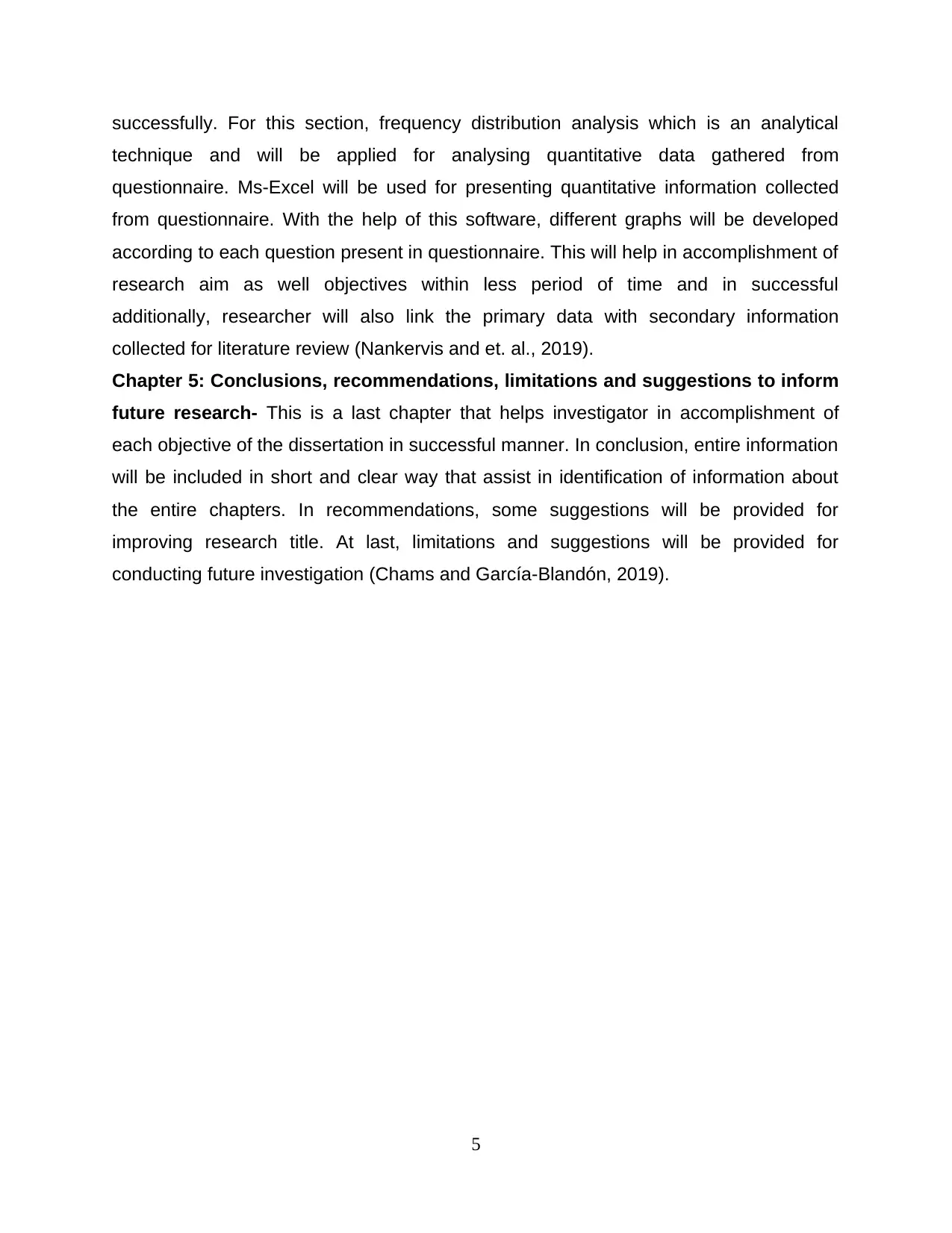
successfully. For this section, frequency distribution analysis which is an analytical
technique and will be applied for analysing quantitative data gathered from
questionnaire. Ms-Excel will be used for presenting quantitative information collected
from questionnaire. With the help of this software, different graphs will be developed
according to each question present in questionnaire. This will help in accomplishment of
research aim as well objectives within less period of time and in successful
additionally, researcher will also link the primary data with secondary information
collected for literature review (Nankervis and et. al., 2019).
Chapter 5: Conclusions, recommendations, limitations and suggestions to inform
future research- This is a last chapter that helps investigator in accomplishment of
each objective of the dissertation in successful manner. In conclusion, entire information
will be included in short and clear way that assist in identification of information about
the entire chapters. In recommendations, some suggestions will be provided for
improving research title. At last, limitations and suggestions will be provided for
conducting future investigation (Chams and García-Blandón, 2019).
5
technique and will be applied for analysing quantitative data gathered from
questionnaire. Ms-Excel will be used for presenting quantitative information collected
from questionnaire. With the help of this software, different graphs will be developed
according to each question present in questionnaire. This will help in accomplishment of
research aim as well objectives within less period of time and in successful
additionally, researcher will also link the primary data with secondary information
collected for literature review (Nankervis and et. al., 2019).
Chapter 5: Conclusions, recommendations, limitations and suggestions to inform
future research- This is a last chapter that helps investigator in accomplishment of
each objective of the dissertation in successful manner. In conclusion, entire information
will be included in short and clear way that assist in identification of information about
the entire chapters. In recommendations, some suggestions will be provided for
improving research title. At last, limitations and suggestions will be provided for
conducting future investigation (Chams and García-Blandón, 2019).
5
Paraphrase This Document
Need a fresh take? Get an instant paraphrase of this document with our AI Paraphraser
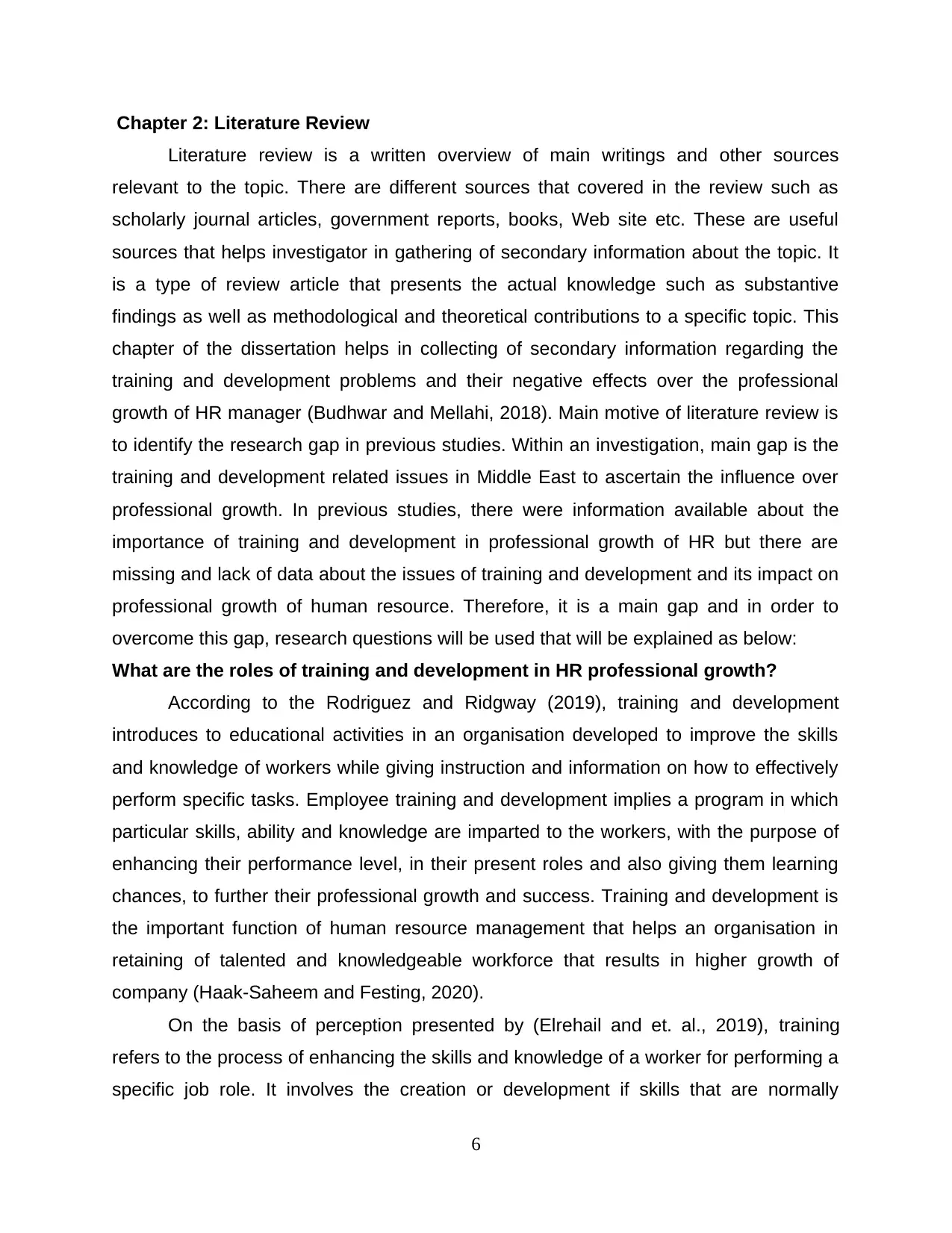
Chapter 2: Literature Review
Literature review is a written overview of main writings and other sources
relevant to the topic. There are different sources that covered in the review such as
scholarly journal articles, government reports, books, Web site etc. These are useful
sources that helps investigator in gathering of secondary information about the topic. It
is a type of review article that presents the actual knowledge such as substantive
findings as well as methodological and theoretical contributions to a specific topic. This
chapter of the dissertation helps in collecting of secondary information regarding the
training and development problems and their negative effects over the professional
growth of HR manager (Budhwar and Mellahi, 2018). Main motive of literature review is
to identify the research gap in previous studies. Within an investigation, main gap is the
training and development related issues in Middle East to ascertain the influence over
professional growth. In previous studies, there were information available about the
importance of training and development in professional growth of HR but there are
missing and lack of data about the issues of training and development and its impact on
professional growth of human resource. Therefore, it is a main gap and in order to
overcome this gap, research questions will be used that will be explained as below:
What are the roles of training and development in HR professional growth?
According to the Rodriguez and Ridgway (2019), training and development
introduces to educational activities in an organisation developed to improve the skills
and knowledge of workers while giving instruction and information on how to effectively
perform specific tasks. Employee training and development implies a program in which
particular skills, ability and knowledge are imparted to the workers, with the purpose of
enhancing their performance level, in their present roles and also giving them learning
chances, to further their professional growth and success. Training and development is
the important function of human resource management that helps an organisation in
retaining of talented and knowledgeable workforce that results in higher growth of
company (Haak-Saheem and Festing, 2020).
On the basis of perception presented by (Elrehail and et. al., 2019), training
refers to the process of enhancing the skills and knowledge of a worker for performing a
specific job role. It involves the creation or development if skills that are normally
6
Literature review is a written overview of main writings and other sources
relevant to the topic. There are different sources that covered in the review such as
scholarly journal articles, government reports, books, Web site etc. These are useful
sources that helps investigator in gathering of secondary information about the topic. It
is a type of review article that presents the actual knowledge such as substantive
findings as well as methodological and theoretical contributions to a specific topic. This
chapter of the dissertation helps in collecting of secondary information regarding the
training and development problems and their negative effects over the professional
growth of HR manager (Budhwar and Mellahi, 2018). Main motive of literature review is
to identify the research gap in previous studies. Within an investigation, main gap is the
training and development related issues in Middle East to ascertain the influence over
professional growth. In previous studies, there were information available about the
importance of training and development in professional growth of HR but there are
missing and lack of data about the issues of training and development and its impact on
professional growth of human resource. Therefore, it is a main gap and in order to
overcome this gap, research questions will be used that will be explained as below:
What are the roles of training and development in HR professional growth?
According to the Rodriguez and Ridgway (2019), training and development
introduces to educational activities in an organisation developed to improve the skills
and knowledge of workers while giving instruction and information on how to effectively
perform specific tasks. Employee training and development implies a program in which
particular skills, ability and knowledge are imparted to the workers, with the purpose of
enhancing their performance level, in their present roles and also giving them learning
chances, to further their professional growth and success. Training and development is
the important function of human resource management that helps an organisation in
retaining of talented and knowledgeable workforce that results in higher growth of
company (Haak-Saheem and Festing, 2020).
On the basis of perception presented by (Elrehail and et. al., 2019), training
refers to the process of enhancing the skills and knowledge of a worker for performing a
specific job role. It involves the creation or development if skills that are normally
6
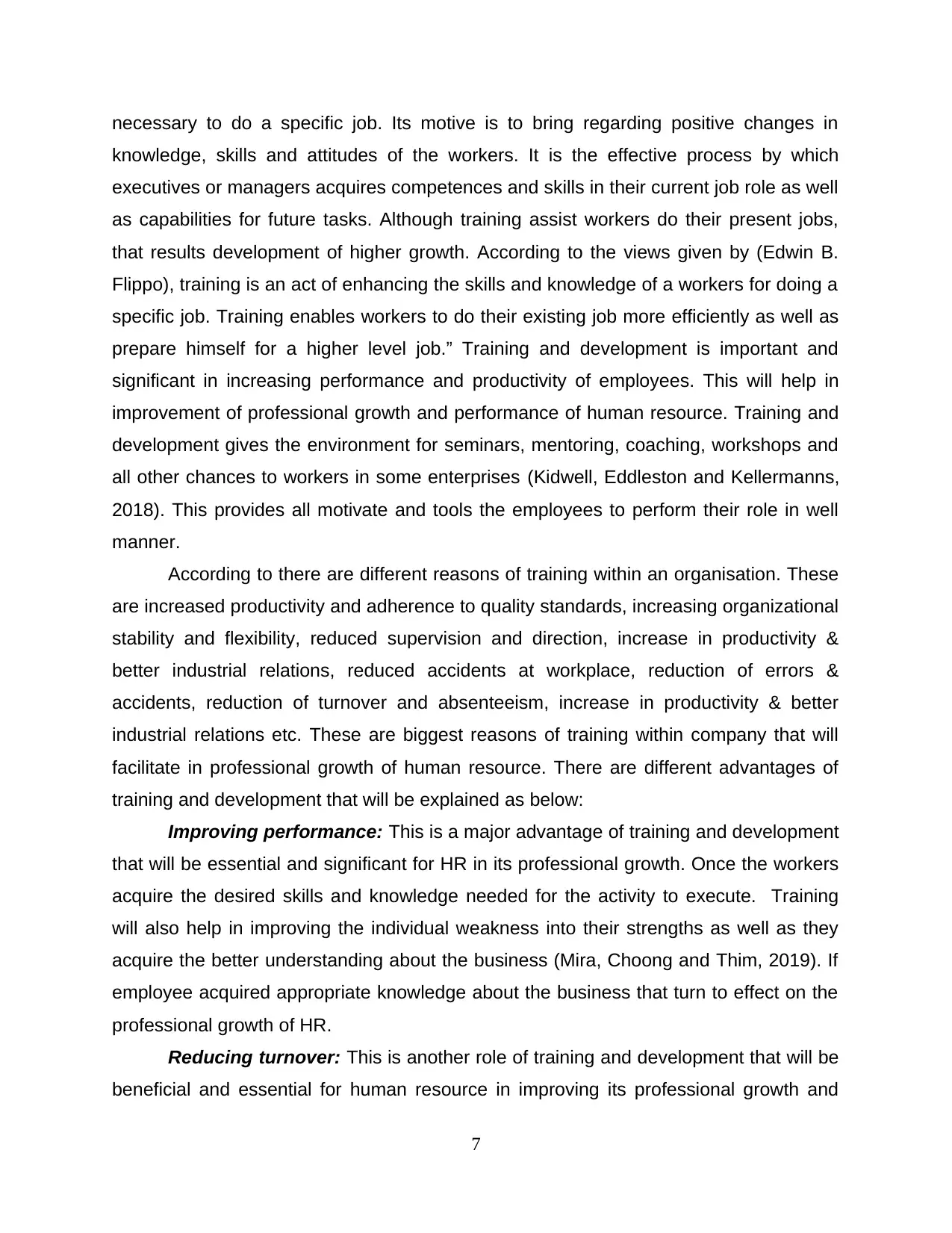
necessary to do a specific job. Its motive is to bring regarding positive changes in
knowledge, skills and attitudes of the workers. It is the effective process by which
executives or managers acquires competences and skills in their current job role as well
as capabilities for future tasks. Although training assist workers do their present jobs,
that results development of higher growth. According to the views given by (Edwin B.
Flippo), training is an act of enhancing the skills and knowledge of a workers for doing a
specific job. Training enables workers to do their existing job more efficiently as well as
prepare himself for a higher level job.” Training and development is important and
significant in increasing performance and productivity of employees. This will help in
improvement of professional growth and performance of human resource. Training and
development gives the environment for seminars, mentoring, coaching, workshops and
all other chances to workers in some enterprises (Kidwell, Eddleston and Kellermanns,
2018). This provides all motivate and tools the employees to perform their role in well
manner.
According to there are different reasons of training within an organisation. These
are increased productivity and adherence to quality standards, increasing organizational
stability and flexibility, reduced supervision and direction, increase in productivity &
better industrial relations, reduced accidents at workplace, reduction of errors &
accidents, reduction of turnover and absenteeism, increase in productivity & better
industrial relations etc. These are biggest reasons of training within company that will
facilitate in professional growth of human resource. There are different advantages of
training and development that will be explained as below:
Improving performance: This is a major advantage of training and development
that will be essential and significant for HR in its professional growth. Once the workers
acquire the desired skills and knowledge needed for the activity to execute. Training
will also help in improving the individual weakness into their strengths as well as they
acquire the better understanding about the business (Mira, Choong and Thim, 2019). If
employee acquired appropriate knowledge about the business that turn to effect on the
professional growth of HR.
Reducing turnover: This is another role of training and development that will be
beneficial and essential for human resource in improving its professional growth and
7
knowledge, skills and attitudes of the workers. It is the effective process by which
executives or managers acquires competences and skills in their current job role as well
as capabilities for future tasks. Although training assist workers do their present jobs,
that results development of higher growth. According to the views given by (Edwin B.
Flippo), training is an act of enhancing the skills and knowledge of a workers for doing a
specific job. Training enables workers to do their existing job more efficiently as well as
prepare himself for a higher level job.” Training and development is important and
significant in increasing performance and productivity of employees. This will help in
improvement of professional growth and performance of human resource. Training and
development gives the environment for seminars, mentoring, coaching, workshops and
all other chances to workers in some enterprises (Kidwell, Eddleston and Kellermanns,
2018). This provides all motivate and tools the employees to perform their role in well
manner.
According to there are different reasons of training within an organisation. These
are increased productivity and adherence to quality standards, increasing organizational
stability and flexibility, reduced supervision and direction, increase in productivity &
better industrial relations, reduced accidents at workplace, reduction of errors &
accidents, reduction of turnover and absenteeism, increase in productivity & better
industrial relations etc. These are biggest reasons of training within company that will
facilitate in professional growth of human resource. There are different advantages of
training and development that will be explained as below:
Improving performance: This is a major advantage of training and development
that will be essential and significant for HR in its professional growth. Once the workers
acquire the desired skills and knowledge needed for the activity to execute. Training
will also help in improving the individual weakness into their strengths as well as they
acquire the better understanding about the business (Mira, Choong and Thim, 2019). If
employee acquired appropriate knowledge about the business that turn to effect on the
professional growth of HR.
Reducing turnover: This is another role of training and development that will be
beneficial and essential for human resource in improving its professional growth and
7
⊘ This is a preview!⊘
Do you want full access?
Subscribe today to unlock all pages.

Trusted by 1+ million students worldwide
1 out of 62
Related Documents
Your All-in-One AI-Powered Toolkit for Academic Success.
+13062052269
info@desklib.com
Available 24*7 on WhatsApp / Email
![[object Object]](/_next/static/media/star-bottom.7253800d.svg)
Unlock your academic potential
Copyright © 2020–2025 A2Z Services. All Rights Reserved. Developed and managed by ZUCOL.





